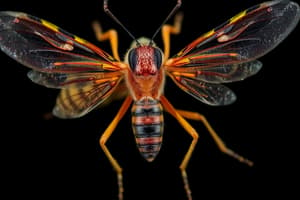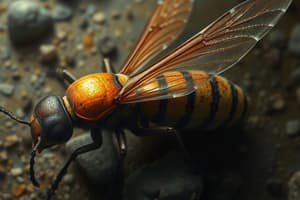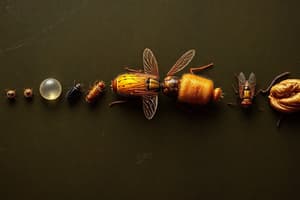Podcast
Questions and Answers
What is the main factor that influences the growth and development rate of blowflies?
What is the main factor that influences the growth and development rate of blowflies?
- Food quality
- Predator presence
- Species and temperature (correct)
- Humidity
Which stage of blowfly metamorphosis lasts the longest?
Which stage of blowfly metamorphosis lasts the longest?
- Pupa
- 1st instar
- Eggs
- 3rd instar (correct)
Which insect is considered most useful for determining a more accurate Postmortem Interval (PMI)?
Which insect is considered most useful for determining a more accurate Postmortem Interval (PMI)?
- Mosquitoes
- Blowflies (correct)
- Butterflies
- Ants
How long does it take for blowfly eggs to hatch after being laid?
How long does it take for blowfly eggs to hatch after being laid?
What is the primary reason that rigor mortis complicates determining PMI after 72 hours?
What is the primary reason that rigor mortis complicates determining PMI after 72 hours?
What is the primary focus of forensic entomology?
What is the primary focus of forensic entomology?
Which event marked the first recorded case of using insect evidence in a criminal investigation?
Which event marked the first recorded case of using insect evidence in a criminal investigation?
What conclusion was derived from the analysis of the maggots found on the bodies in the Jigsaw Murders case?
What conclusion was derived from the analysis of the maggots found on the bodies in the Jigsaw Murders case?
Which of the following statements about insects is true?
Which of the following statements about insects is true?
What characteristic is notable about blowflies?
What characteristic is notable about blowflies?
Flashcards
What is Entomology?
What is Entomology?
The branch of science that studies insects.
What is Forensic Entomology?
What is Forensic Entomology?
The use of insect evidence in criminal investigations.
What is the Sung Tzu case?
What is the Sung Tzu case?
The first recorded case of using insect evidence in a murder investigation. A lawyer used the presence of flies on a sickle to find the murderer.
Describe Insects.
Describe Insects.
Signup and view all the flashcards
How are blowflies used in forensic investigations?
How are blowflies used in forensic investigations?
Signup and view all the flashcards
Metamorphosis
Metamorphosis
Signup and view all the flashcards
Blowfly Larvae
Blowfly Larvae
Signup and view all the flashcards
Postmortem Interval (PMI)
Postmortem Interval (PMI)
Signup and view all the flashcards
Carrion Beetle
Carrion Beetle
Signup and view all the flashcards
Fresh Stage Decomposition
Fresh Stage Decomposition
Signup and view all the flashcards
Study Notes
Introduction to Forensic Entomology
- Entomology is the study of insects
- Forensic entomology is the study of the application of insects in criminal investigations
- The first recorded case of using insect evidence was in China in 1235, involving a murder case
- Flies congregated on a sickle, leading to the murderer's confession
- The Jigsaw Murders involved the analysis of maggots found on bodies, determining their age and the time of death
- Buck Ruxton was convicted for the murder of his wife and house maid through the use of forensic entomology
- Insects are invertebrate animals with exoskeletons and six legs, making up more than half of all living organisms
- They live in nearly all environments, including Antarctica and the Arctic Circle
- Insects often have multiple stages of growth and molt from one exoskeleton to another
Insect Anatomy
- Insect bodies are divided into three segments: head, thorax, and abdomen
- Head components include the brain, two antennae, eyes, and mouth
- Thorax has three pairs of legs and wings (if applicable)
- Abdomen houses the digestive and reproductive systems
Insect Spotlight: Blowfly
- Blowflies (Calliphoridae) have around 1,900 species with metallic coloring (green, blue, or black)
- They have a strong sense of smell and can detect dead animals (carrion) up to a mile away
- Blowflies lay eggs on carrion; the eggs develop into larvae (maggots)
- The rate of their development is heavily influenced by temperature and species
Metamorphosis
- Metamorphosis is a biological process of development involving an abrupt change in body structure
- Blowfly metamorphosis has four stages:
- Eggs: laid on carrion, hatch in about 24 hours
- Larvae (maggots):
- Three instar stages: 1st, 2nd, and 3rd
- Grow in size and shed their exoskeletons, taking 1-5 days to complete
- The 3rd instar stage lasts ~4-5 days before entering the ground
- Pupa
- Adult Blowfly
Postmortem Time Interval (PMI)
- PMI is the time between death and the discovery of a body
- Insects help determine a more accurate PMI by following their life-cycle stages
- The more variety and number of insects, the more accurate the determination of the PMI
- Common insects include blowflies and beetles
Insect Spotlight: Carrion Beetle
- Carrion beetles feed on carrion (dead animals)
- They bury their food underground, have several stages of metamorphosis, taking ~2 -7 days to hatch, up to 30 days for larva stages and up to a few more for pupation
Active Stage Decomposition & Insects
- The active decay stage begins when maggots pierce the skin; internal gases are released, and the carcass deflates and begins to smell more strongly
- Blowflies are the most common insect during active decay, often found in orifices and moving to chests and stomachs
- Black scavenger flies and beetles, like rove and hister beetles, become dominant at this stage, feeding on other insects
Advanced & Dry Decay Stage Decomposition
- Advanced decay is marked by the mass movement of blowfly larvae to pupate and adult blowflies leave
- Adult skin beetles have also emerged
- The dry stage of decomposition shows skeletal remains with dried skin, and adult cheese flies might emerge
Factors Affecting Insect Activity
- High humidity and temperatures speed up insect activity
- Cold temperatures and heavy rain slow it down
Drug Use & Insects
- Forensic entomologists can determine toxins (e.g., heroin, cocaine) in insects that aid in decomposition studies, mainly from blowflies and beetles, to reveal information about the cause of death
How to Collect Insects
- Use insect nets, glass vials, forceps, and 70% ethanol solutions
- Carefully collect insects near the body, wounds, and openings and place in glass vials with preservatives
How to Collect Maggots
- Record temperature and air conditions at the site before collecting maggots
- Collect largest maggots into a breathable container with liver in potting soil
- Date, time, body part, and investigator initials should be documented on containers
Documentation of Entomological Evidence
- Thoroughly record all climatic conditions of the area for at least two weeks preceding the discovery of a body, including temperature, precipitation, wind, humidity, and cloud cover.
Studying That Suits You
Use AI to generate personalized quizzes and flashcards to suit your learning preferences.




